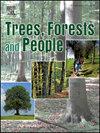Inventory of wood specific gravity for Indian forests
IF 2.7
Q1 FORESTRY
引用次数: 0
Abstract
Wood specific gravity (WSG) is one of the most important functional traits of plants that helps in minimizing the variability of biomass estimates generated due to the inter-specific and intra-specific variations. Assemblage of an integrated inventory of WSG for various species from different forest groups, vegetation types is expected to provide crucial insights in the problems related to biomass estimation and serve as a standard reference for ecological research particularly on carbon dynamics and functional diversity studies by providing vegetational specific WSG values for a number of species at one place. Survey of literature for WSG in Indian forest communities showed that WSG values of 879 individuals belonging to 351 species, 221 genus and 77 families are available for eleven forest groups of India. Result showed that species present in a particular forest group and climatic condition showed a different value for WSG than the similar species present in other forest types and climatic conditions. It also showed that Eugenia utilis has the highest WSG (0.98) for Indian forests and it was lowest for Dalbergia sissoo (0.05). Further, we observed that in case of mature individuals, WSG value of maximum number of species was found between 0.61 to 0.80 whereas, for juvenile individuals, it was maximum between 0.41 to 0.60 indicating the role of tree diameter in WSG. In addition, we observed that tropical dry deciduous forest had the widest range of distribution for WSG. Moreover, the WSG value of species in hilly terrains showed variation with similar species present in tropical and subtropical areas. The present dataset also showed that highest WSG value was found for species present in tropical wet evergreen forest while lowest was found for tropical dry deciduous forest indicating the effect of precipitation in increasing WSG. The present dataset would of great importance for future studies particularly focusing on biomass estimation and functional trait by providing WSG values for a large number of species.
印度森林木材比重清单
木材比重(WSG)是植物最重要的功能性状之一,它有助于最小化由于种间和种内变化而产生的生物量估计的变异。来自不同森林类群和植被类型的不同物种的WSG综合清单,有望为与生物量估算相关的问题提供重要见解,并通过提供一个地方多个物种的特定植被WSG值,为生态学研究,特别是碳动态和功能多样性研究提供标准参考。对印度森林群落WSG的文献调查表明,印度11个森林类群的WSG值为77科221属351种879个个体。结果表明,特定林群和气候条件下的物种与其他林种和气候条件下的相似物种的WSG值不同。结果表明,印度林Eugenia utilis的WSG最高(0.98),Dalbergia sissoo最低(0.05)。在成熟个体中,最大种数WSG值在0.61 ~ 0.80之间,而在幼龄个体中,最大种数WSG值在0.41 ~ 0.60之间,说明树径对WSG的影响。此外,我们还观察到热带干燥落叶林的WSG分布范围最广。此外,丘陵地区物种的WSG值与热带和亚热带地区相似。热带湿常绿林物种的WSG值最高,热带干落叶林物种的WSG值最低,表明降水对WSG的增加有影响。通过提供大量物种的WSG值,本数据集对未来的生物量估算和功能性状研究具有重要意义。
本文章由计算机程序翻译,如有差异,请以英文原文为准。
求助全文
约1分钟内获得全文
求助全文
来源期刊

Trees, Forests and People
Economics, Econometrics and Finance-Economics, Econometrics and Finance (miscellaneous)
CiteScore
4.30
自引率
7.40%
发文量
172
审稿时长
56 days
 求助内容:
求助内容: 应助结果提醒方式:
应助结果提醒方式:


